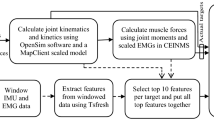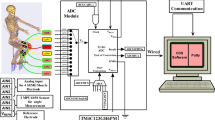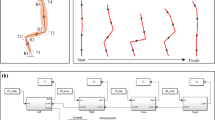Abstract
The aim of this study is to estimate the joint moments of the ankle, knee, and hip joints during walking. A sit-to-stand (STS) movement analysis was first performed on 20 participants with different anthropometric characteristics. Then, analysis of the dynamics of the STS motion was used to develop a biomechanical model. Decision tree (DT), linear regression (LR), support vector machine (SVM), random forest (RF), and three deep learning (DL) algorithms and deep neural network (DNN), long-short-term memory (LSTM), and convolutional neural network (CNN) are examined in this work to estimate three joint moments: ankle, knee, and hip. The results of the seven algorithms were evaluated using four statistical benchmarks: MSR, RMSE, correlation coefficient (R), and MAE to find the most accurate one. The results show that the most successful algorithms were LSTM in estimating knee, hip, and ankle joint moments using 19 and 7 inputs. The R value was 0.9990 using 19 inputs and 0.9972 using 7 inputs. The other algorithms have a correlation coefficient (R) success of 0.9902, 0.9770, 0.9884, 0.9577, 0.9786, and 0.9022 for RF, CNN, DT, DNN, SVM, and LR, respectively. The prediction of joint moments plays a crucial role in the design of the biomechanical system with the desired mechanical properties. Especially, the need has arisen to predict joint moments in a shorter time to utilize in real-time active prosthesis/orthosis controllers.
Graphical abstract











Similar content being viewed by others
Change history
15 September 2023
A Correction to this paper has been published: https://doi.org/10.1007/s11517-023-02909-9
References
Shkedy Rabani A, Mizrachi S, Sawicki GS, Riemer R (2022) Parametric equations to study and predict lower-limb joint kinematics and kinetics during human walking and slow running on slopes. PloS one 17(8):e0269061
Yamagata M, Tateuchi H, Asayama A, Ichihashi N (2022) Influence of lower-limb muscle inactivation on medial and lateral knee contact forces during walking. Med Eng Phys 108:103889
Banks JJ, Umberger BR, Caldwell GE (2022) EMG optimization in Open- Sim: a model for estimating lower back kinetics in gait. Med Eng Phys 103:103790
Cilli M, Serbest K, Kayaoglu E (2021) The effect of body weight on joint torques in teenagers: investigation of sit-to-stand movement. Clinical Biomech 83:105288
Hahn ME (2007) Feasibility of estimating isokinetic knee torque using a neural network model. J Biomech 40(5):1107–1114
Ardestani MM, Zhang X, Wang L et al (2014) Human lower extremity joint moment prediction: a wavelet neural network approach. Expert Syst App 41(9):4422–4433
Xiong B, Zeng N, Li H et al (2019) Intelligent prediction of human lower extremity joint moment: an artificial neural network approach. IEEE Access 7:29973–29980
Mundt M, Koeppe A, David S et al (2020) Estimation of gait mechanics based on simulated and measured IMU data using an artificial neural network. Frontiers in bioengineering and biotechnology 8:41
Zhang Q, Clark WH, Franz JR, Sharma N (2022) Personalized fusion of ultrasound and electromyography-derived neuromuscular features increases prediction accuracy of ankle moment during plantarflexion. Biomed Signal Process Control 71:103100
Zell P, Rosenhahn B (2020) Learning inverse dynamics for human locomotion analysis. Neural Comput App 32(15):11729–11743
Burton IIWS, Myers CA, Rullkoetter PJ (2021) Machine learning for rapid estimation of lower extremity muscle and joint loading during activities of daily living. J Biomech 123:110439
Prentice AM, Jebb SA (2001) Beyond body mass index. Obes Rev 2(3):141–147
Mohajan D, Mohajan HK (2023) Body mass index (BMI) is a popular anthropometric tool to measure obesity among adults. J Innov Med Res 2(4):25–33
Organization WH (2000) Obesity: preventing and managing the global epidemic
Kuo YL, Tully EA, Galea MP (2010) Kinematics of sagittal spine and lower limb movement in healthy older adults during sit-to-stand from two seat heights. Spine 35(1):E1–E7
Kadaba MP, Ramakrishnan H, Wootten M (1990) Measurement of lower extremity kinematics during level walking. J Orthop Res 8(3):383–392
Zajac FE, Neptune RR, Kautz SA (2002) Biomechanics and muscle coordination of human walking: Part I: Introduction to concepts, power transfer, dynamics and simulations. Gait & Posture 16(3):215–232
Yeadon MR (1990) The simulation of aerial movement—II. A mathematical inertia model of the human body. J Biomech 23(1):67–74
Mansouri M, Reinbolt JA (2012) A platform for dynamic simulation and control of movement based on OpenSim and MATLAB. J Biomech 45(8):1517–1521
Abtahi SMA, Jamshidi N, Ghaziasgar A (2018) The effect of knee-ankle- foot orthosis stiffness on the parameters of walking. Comput Methods Biomech Biomed Eng 21(3):201–207
Trentin E (2015) Maximum-likelihood normalization of features increases the robustness of neural-based spoken human-computer interaction. Pattern Recogn Lett 66:71–80
Senvar O, Sennaroglu B (2016) Comparing performances of Clements, Box-Cox, Johnson methods with Weibull distributions for assessing process capability. J Ind Eng Manag 9(3):634–656
Singh D, Singh B (2020) Investigating the impact of data normalization on classification performance. Appl Soft Comput 97:105524
Karapinar Senturk Z, Sevgul Bakay M (2021) Machine learning- based hand gesture recognition via EMG data
Alpaydin E (2020) Introduction to machine learning. MIT press
Akour I, Alshurideh M, Al Kurdi B, Al Ali A, Salloum S (2021) Using machine learning algorithms to predict people’s intention to use mobile learning platforms during the COVID-19 pandemic: machine learning approach. JMIR Med Educ 7(1):e24032
Quiroz JC, Feng YZ, Cheng ZY et al (2021) Development and validation of a machine learning approach for automated severity assessment of COVID-19 based on clinical and imaging data: retrospective study. JMIR Med Inf 9(2):e24572
Najafabadi MM, Villanustre F, Khoshgoftaar TM, Seliya N, Wald R, Muharemagic E (2015) Deep learning applications and challenges in big data analytics. J Big Data 2(1):1–21
Miyato T, Si Maeda, Koyama M, Ishii S (2018) Virtual adversarial training: a regularization method for supervised and semi-supervised learning. IEEE Trans Pattern Anal Mach Intell 41(8):1979–1993
Chen Y,Wang X, Zhang B (2018) An unsupervised deep learning approach for scenario forecasts. In: IEEE. 1–7
Boser BE, Guyon IM, Vapnik VN (1992) A training algorithm for optimal margin classifiers. In: 144–152
Wen L, Cao Y (2020) Influencing factors analysis and forecasting of residential energy-related CO2 emissions utilizing optimized support vector machine. J Clean Prod 250:119492
Zhang Z, Li Y, Li L, Li Z, Liu S (2019) Multiple linear regression for high efficiency video intra coding. In: IEEE. 1832–1836
Das R (2010) A comparison of multiple classification methods for diagnosis of Parkinson disease. Expert Syst Appl 37(2):1568–1572
Kumar SA et al (2011). Efficiency of decision trees in predicting student’s academic performance
Saber M, El Rharras A, Saadane R, Aroussi HK, Wahbi M (2019) Artificial neural networks, support vector machine and energy detection for spectrum sensing based on real signals. Int J Commun Netw Inf Secur 11(1):52–60
Agrawal SK, Banala SK, Fattah A et al (2007) Assessment of motion of a swing leg and gait rehabilitation with a gravity balancing exoskeleton. IEEE Trans Neural Sys Rehabil Eng 15(3):410–420
Mapaisansin P, Suriyaamarit D, Boonyong S (2020) The development of sit-to-stand in typically developing children aged 4 to 12 years: movement time, trunk and lower extremity joint angles, and joint moments. Gait & Posture 76:14–21
Schmid S, Luder G, Mebes CM et al (2013) Neuromechanical gait adaptations in women with joint hypermobility-an exploratory study. Clin Biomech 28(9–10):1020–1025
Mundt M, Thomsen W, Witter T et al (2020) Prediction of lower limb joint angles and moments during gait using artificial neural networks. Med Biol Eng Comput 58(1):211–225
Author information
Authors and Affiliations
Corresponding author
Ethics declarations
Conflict of interest
The authors declare no competing interests.
Additional information
Publisher's Note
Springer Nature remains neutral with regard to jurisdictional claims in published maps and institutional affiliations.
The original online version of this article was revised: Graphical abstract image was incorrect.
Rights and permissions
Springer Nature or its licensor (e.g. a society or other partner) holds exclusive rights to this article under a publishing agreement with the author(s) or other rightsholder(s); author self-archiving of the accepted manuscript version of this article is solely governed by the terms of such publishing agreement and applicable law.
About this article
Cite this article
Mansour, M., Serbest, K., Kutlu, M. et al. Estimation of lower limb joint moments based on the inverse dynamics approach: a comparison of machine learning algorithms for rapid estimation. Med Biol Eng Comput 61, 3253–3276 (2023). https://doi.org/10.1007/s11517-023-02890-3
Received:
Accepted:
Published:
Issue Date:
DOI: https://doi.org/10.1007/s11517-023-02890-3
























